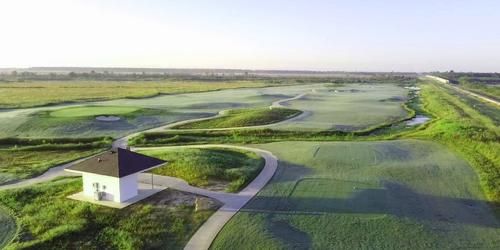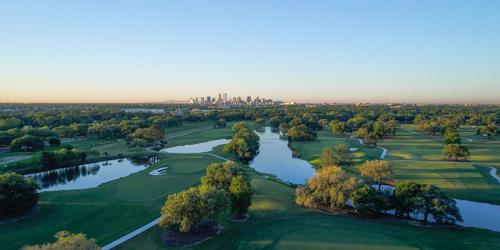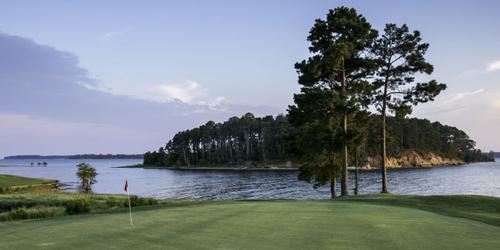
Baton Rouge Golf Guide
Hunting for flags, not red stick, in Baton Rouge
By Steve Habel
Seven flags have flown over Baton Rouge, the capitol of Louisiana and the second largest city in the Pelican State, but on a recent trip to the area we were most interested in the flags that demarcated the holes at its various and challenging golf courses.
Along the way we learned a little about the history of the city, whose name in English means "red stick," and enjoyed our time with some of the people and personalities in the region.
When French explorer Sieur d'Iberville led an exploration party up the Mississippi River in 1699, his crew saw a red pole on bluff that marked the boundary between the Houma and Bayogoula tribal hunting grounds. The location of the red pole - which was 30-feet tall and adorned with fish bones - was at Scott's Bluff, on what is now the campus of Southern University.
In the years since the French placed a garrison on the bluff in 1721, Baton Rouge has become the hub of all things Louisiana. With its prime, central location - just an hour away from New Orleans to the east and Lafayette to the west - the city houses over 300 years of history and is the perfect place to explore Louisiana's eclectic culture and to get in a handful of great rounds of golf.
Our first stop on our latest trip was at Pelican Point Golf Club, a 27-hole facility set in Gonzales, about a half-hour east of Baton Rouge.
Developed by Douglas Diez in 1997 with its course opened in a year later, Pelican Point is located just off the banks of the Mississippi River and behind the historic Houmas House Plantation, which allows the golf course and surrounding community to combine British-style golf with some Louisiana flair.
The biggest draw here is the facility's Links Course, which offers generous fairways, large greens and four sets of tees that low the track to be fun and playable for all levels of golfers. The Links' final three-hole stretch - the 480-yard par 5 16th, which ends at a green surrounded by water; the 204 yard par-3 17th and the left-bending 437-yard uphill closing hole - provide for a dramatic ending to challenging round of golf.
Pelican Point also offers its Get Golf Ready Course, which was formerly the back nine of the recently closed Lakes course. It was designed to enhance the enjoyment of beginning golfers and is a wonderful place to bring the entire family out for an enjoyable day playing and learning the game of golf.
Pelican Point has been selected by Golf Digest magazine as one of the Best Places to Play in Louisiana.
For public golf in the city of Baton Rouge itself, it's hard to beat Santa Maria Golf Course.
Considered a municipal course because it's now owned by the city, Santa Maria GC was designed by renowned golf architect Robert Trent Jones to be the centerpiece of an upscale community that's set just one mile off historic Highland Road near I-10.
Santa Maria GC looks and plays like a championship course. It is built on 150 acres of rolling terrain and features 15 ponds and two natural waterways for golfers to transverse and avoid. Sand and grass bunkers, exquisite Bermuda fairways and ancient oaks provide the perfect setting for a memorable test of golf. The 18-hole course measures 6,969 yards in length from the back tees.
Santa Maria GC has a history of being recognized as one of the best public golf courses in southeast Louisiana and has earned Golf Digest's highest ranking for a municipal course. It is a must-play when in Baton Rouge.
Speaking of must-plays, The Bluffs on Thompson Creek - about 45 minutes north of downtown Baton Rouge - demands the golfers' attention.
Ranked through the years as one of the best public courses in Louisiana (and rightfully so) The Bluffs is an Arnold Palmer design that takes advantage of the hills, bluffs, and hollows of the varied landscape. Golfers face uneven lies and a few blind shots thanks to the terrain but also get scenic views of the surrounding area. Creeks freely meander throughout the golf course, interconnecting with the sparkling ponds that can be found throughout.
Palmer was granted complete freedom to route his golf course at The Bluffs through each of the diverse landscapes of the property, and eight separate routings were staked and walked before the best 18 holes were discovered.
As with many Palmer courses, The Bluffs rewards the risk-taker and accurate shot-maker. Almost every offering could be considered the facility's "signature hole." However, it is the No. 17 that provides the most memorable and lasting impression with its 60-foot drop from the tee to a deep green guarded by Thompson Creek on two sides. In fact, that hole was selected as one of the features in "The King's Dream 18" by Kingdom Magazine.
A trip to the past is en vogue when the player moves east and south beyond Baton Rouge to Plaquemine, home of The Island County Club and its surrounding burgeoning neighborhood. Just 14 miles from the state capital's downtown sector and across the big bridge over the Mississippi, The Island was selected as one the inaugural members of the Audubon Golf Trail.
Carved from a sugarcane plantation that has been owned by the Wilbert family for more than 150 years, The Island GC is so called because 17 of its 18 holes are surrounded by the waters of Bayou Plaquemine and Bayou Jacob. Sugarcane still grows in the field next to course, and the isolation here is only threatened (rarely) by the sound of a passing train or the whistle of a barge working the Mississippi just over the horizon.
Designed by Mike Young (who also designed Alexandria, LA's Links on the Bayou and Long Shadow in Madison, GA, among scores of others), The Island has gained footing from golfers around south Louisiana as a demanding test of golf and an unspoiled destination for a quiet retreat or corporate outing. The track has been featured on the Golf Channel and in Golf Magazine and has hosted events conducted by the Adams Tight Lies Tour.
Golfers up for the challenge at The Island owe it to themselves to head a few miles further south to spend an evening at Nottoway Plantation, the South's largest remaining antebellum mansion.
With its towering size, hand-carved marble mantles and intricate plaster frieze work, visitors are awed with Nottoway's grandeur and innovative features. The 64-room, three-story palatial mansion is sometimes referred to as an "American castle."
Nottoway was completed in 1859 and boasts a main house of more than 53,000 square feet designed by renowned architect Henry Howard of New Orleans in Greek revival and Italianate style. The site originally sat on 400 acres of highland and 620 acres of swamp.
Nottoway survived through the Civil War, a variety of owners, and disrepair to become one of the most visited plantations in the South. Nottoway recently completed a dramatic, multi-million-dollar renovation that has restored this historic plantation to her days of glory as well as adding luxury resort amenities and corporate and social event venues.
Revised: 04/25/2016 - Article Viewed 32,045 Times
About: Steve Habel
![]() Steve Habel is a contributing editor for GolfTrips and its associated websites. A 26-year industry veteran, he regularly contributes to various regional, national and international golf publications and has played and written about more than 1,600 golf courses around the world.
Steve Habel is a contributing editor for GolfTrips and its associated websites. A 26-year industry veteran, he regularly contributes to various regional, national and international golf publications and has played and written about more than 1,600 golf courses around the world.
Habel is also senior editor for Horns Illustrated magazine, a publication focusing on University of Texas sports, as well the San Antonio Spurs beat writer for The Sports Xchange. He is a correspondent for the Austin American-Statesman and frequently files stories and features for The Associated Press and Preferred Lifestyle magazine.
Habel, who lives in the Austin, Texas area, has worked media coordinator for World Golf Hall of Fame player and golf architect Tom Kite as well as for renowned golf architects Roy Bechtol and Jeffrey D. Brauer.
He is a member of the Golf Writers Association of America, the Texas Golf Writers Association and the Football Writers Association of America.













